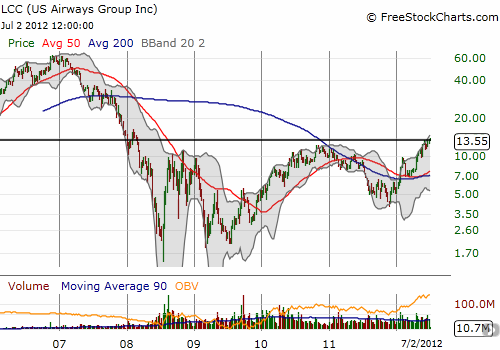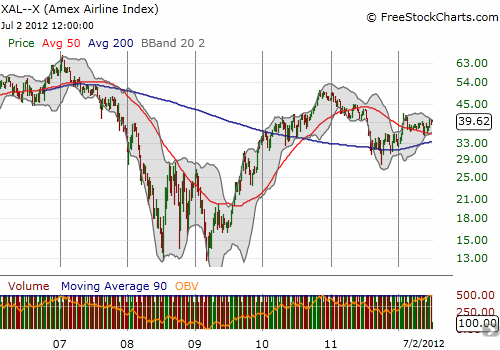(Adapted from the original post at The Thought Blog at Ahan Analytics, LLC)
The stock for U.S. Airways (LCC) is flying high, currently trading at four and half year highs.

This performance is much better than the Amex airline index (XAL) which remains over 20% below highs set in 2010.

Source for charts: FreeStockCharts.com
Clearly, U.S. Airways is doing something right. This performance is all the more impressive in the wake of the bankruptcy filing by American Airlines and the resulting cost pressure felt by Southwest Airlines (LUV) (see “AMR’s Bankruptcy Turns the Cost Spotlight on Southwest“). However, I contend there is at least one thing U.S. Airways is not managing properly, its overhead bin space…
“Attention Passengers on Flight #123. We regret to inform you that the overhead bin space is now full, and we will need to check in your bigger carry-ons.”
This is one of many announcements the modern airline passenger dreads to hear. Ever since airlines started charging for checking-in luggage, passengers have tried to pack as much as they can for a free trip in the overhead bin. (Ironically, the FAA recommends the opposite approach: “Plan to check more of your baggage and carry on less.”) This behavior has turned overhead bins into an ever more precious resource. So imagine the reaction of passengers who are forced to check in carry-ons only to find upon boarding that plenty of overhead bin space remains available. This happened to me on a recent U.S. Airways flight on my way home. (I also overheard an irate passenger on my outbound flight call the airline “liars” after she experienced a false shortage of overhead bin space on a different U.S. Airways flight). This was my return flight home, with an arrival late at night, so I groaned mightily at the prospect of wasting another 20-30 minutes waiting for my bag before I could get home.
I was so irritated that I was compelled to request an explanation from the flight attendant. She just rolled her eyes, shrugged, and innocently purred “I don’t know!” Hardly satisfied, I resolved to tweet my frustration for all the world to see. Upon settling in my seat, I tweeted the following @USAirways:
“USAirways has the worst overhead bin mgmt. for Ed to check in carry-ons only to find PLENTY of space left! Ugh. @USAirways”
(“for Ed” was my iPhone’s best attempt at auto-correcting as I tried to type “Forced”)
I did not expect a response – it is twitter after all, featuring a flurry of messages – but within hours, I actually received an answer that ALMOST sounded human:
“@DrDuru Sorry for the inconvenience. We try our best to ensure all passengers have overhead space. I’ll pass along your feedback. ^KB”
Not satisfied with a 140-character outlet, I sought more catharsis by going to USAirway’s feedback web page, advertised in the twitter profile, once I landed in Phoenix. There, I released my frustration into a full paragraph. I included a customer-friendly strategy of waiting to board absolutely last if I again end up in one of the last boarding groups. If an airline is overly aggressive in checking in carry-ons, this strategy increases the passenger’s odds of capturing empty bin space that went under-counted. For example, if the airline starts checking in carry-ons when 10% of the capacity remains, then the last person to board has a near perfect guarantee to get a space as the airline’s incentive to check-in carry-ons declines rapidly the closer time gets to take-off. In other words, this strategy re-aligns the airline’s incentive to depart on-time with the passenger’s incentive to keep his/her carry-on. I got this idea by watching two guys rush onto the offending flight just in time for take-off with arms full of over-sized bags. They were of course relieved to find PLENTY of space for THEIR bags.
Still unsatisfied, I planned to turn this experience into a lesson and offer unsolicited analytics advice to the airlines on how to better manage overhead bin space. I did get a response to my longer complaint, but I was still not dissuaded from writing this missive. In fact, I became even MORE motivated. Here is what US Airways told me in an emailed response that sounds slightly more human than the tweeted response:
“Thank you for contacting Customer Relations. We appreciate it when customers take the time to share their concerns.
I am sorry that you were not able to take advantage of our overhead bin space to store your carry on baggage. As I am sure you can imagine, with limited space available on our aircraft, we are not able to accommodate all passengers’ bags in the cabin. Our flight attendants are prohibited by federal law from leaving the plane during boarding. Thus, they cannot let the gate agents know precisely when the bins are full. Instead, we use information from past flights to estimate when the bins are full and begin asking customers at that time to check their carry on bags. If your particular flight had less carry on bags than normal, it may be possible that there was still some bin space open when you boarded. We regret any inconvenience.
We look forward to providing a more pleasant flying experience in the future. Thank you for choosing US Airways.
Sincerely,
Rogers Smyth
Representative, Customer Relations
US Airways Corporate Office”
Basically, US Airways told me two things: 1) the airline does not track bin utilization in real-time, instead relying on some rule of thumb on the total number of carry-ons, 2) the airline blames the government for its inability to communicate in real-time between gate agents and flight attendants.
In the rest of this missive, I propose an improved management system for overhead bin space. I am relying on the airline to resolve its communication issues in a way I have witnessed see occur on many previous flights: cell phones, walkie talkies, and/or “runners” who CAN travel between the gate and the plane – or maybe even just good old fashioned shouting down the jetway. (Think about this – how do the flight attendants know when passengers are boarding? How do gate agents know the plane is ready for boarding? How do under-aged children get escorts onto the plane? The list goes on and on…)
A better way to manage overhead bin space
The basis for improving overhead bin management is strict enforcement of existing rules and boarding etiquette:
- Allow only one carry-on and one smaller bag per person, each measuring no more than 45 linear inches (the total of the height, weight, and depth of the carry-on).
- Allow a maximum of one bag in the overhead bin.
- Actively encourage everyone with one bag to store it under the seat in front of them if possible.
- Proactively intervene when someone attempts to put a small bag overhead and confirm there is no space for the bag under a seat.
- Help passengers position bags optimally and make sure all coats and jackets fit on TOP of another bag.
With these foundational rules, the airline should have near optimal conditions for packing carry-ons overhead. Here is the “algorithm”:
- Calculate overhead bin capacity as the number of bags = (number of overhead bins) * (number of bags that fit in one overhead bin) where bags are assumed to be the maximum allowed size.
- If the number of passengers is less than or equal to the maximum number of carry-ons allowed by the capacity, do not pro-actively check-in carry-ons. Relax. Everything will work out fine.
- If the number of passengers is greater than the maximum number of bags (more likely the case given the way airlines cram passengers into planes these days), determine whether to check-in carry-ons only after 80% of expected passengers have boarded. If at least 15% of the capacity remains, do not proactively check-in bags. These percentages should be adjusted based on historical data.
Airport hubs offer the best opportunity for effective overhead bin management since excess carry-ons get captured during the first leg of trips. Case in point, on my trip, ZERO pre-emptive check-ins occurred in either direction after laying over in Phoenix although all my flights were packed to near capacity.
Now, I realize some of these suggestions are already on the rule books for the airlines. However, the end results demonstrate that either the rules receive poor execution and/or are insufficient for ensuring the best passenger experience.
Of course, the airlines have reduced incentive for optimizing overhead bin space. They have turned this precious space into a privilege and a perk. The airlines reward frequent flyers with guaranteed early boarding so that they can comfortably find space for their bags. From personal experience, I believe this part of boarding receives the most lax enforcement of baggage rules…probably because space is plentiful during the early part of boarding. Airlines also now sell the privilege of boarding early, essentially putting an indirect price tag on overhead bin space. Even “no fee” Southwest Airlines offers “early-bird” check-in for an extra $10 one-way. I imagine one day soon airlines will directly charge for overhead access. Maybe at that point, they will auction off overhead bin space so capacity is utilized by those most willing to pay for it. Just tell my boarding group before I place my bid…
